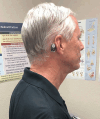Phybrata Digital Biomarkers of Age-Related Balance Impairments, Sensory Reweighting, and Intrinsic Fall Risk
- PMID: 40524937
- PMCID: PMC12168941
- DOI: 10.2147/MDER.S522827
Phybrata Digital Biomarkers of Age-Related Balance Impairments, Sensory Reweighting, and Intrinsic Fall Risk
Abstract
Objective: To assess the utility of digital biomarkers derived from a head-mounted wearable physiological vibration acceleration (phybrata) sensor to quantify age-related balance impairments, sensory reweighting, and fall risks in older populations.
Methods: Data were collected and analyzed from 516 participants aged 77.7 ± 8.0 yrs (min 51 yrs, max 98 yrs, 334 females, 182 males) in 4 residential senior living communities. Participants first completed a questionnaire that included their fall history in the past 6 months. A 2-minute standing balance test was then carried out for each participant using the phybrata sensor (1 minute with eyes open, followed by 1 minute with eyes closed). Four balance performance biomarkers were derived from the phybrata time series data: eyes open (Eo) and eyes closed (Ec) phybrata powers, average phybrata power (Eo+Ec)/2, and Ec/Eo phybrata power ratio. Sensory reweighting biomarkers were derived from phybrata acceleration spectral density (ASD) distributions. Results are compared for participants with no reported fall history (NF) and those reporting one or more falls (FR) in the previous 6 months.
Results: All four phybrata balance performance biomarkers show significantly higher values for FR participants vs NF participants. As a fall risk biomarker, Ec phybrata power was found to have the strongest statistical correlation with the reported retrospective incidence of falls within the previous 6 months. The Ec phybrata biomarker also showed the strongest statistical difference between F and M participants. Phybrata sensory reweighting biomarkers quantify age-related impairments and sensory reweighting across sensory inputs (visual, vestibular, proprioceptive), central nervous system (CNS) processing, and neuromotor control (vestibulocollic reflex), revealing progressive reductions in visual and vestibular balance regulation and vestibulocollic head stabilization that are offset by an increasing reliance on proprioceptive balance control.
Conclusion: Phybrata digital biomarkers enable rapid objective assessment of progressive age-related balance impairments, sensory reweighting, and fall risks in older populations.
Keywords: age-related balance decline; balance performance; biomarker; fall risk; phybrata; presbystasis; sensory reweighting; vestibular; wearable sensor.
© 2025 Ralston et al.
Conflict of interest statement
John D Ralston is the co-founder and CEO of Neursantys, Inc., and has a financial interest in the company. In addition, he reports a US provisional patent application 63/741,968 pending to Neursantys Inc. Josh Roper is the co-founder and Vice President of Operations of Neursantys, Inc., and has a financial interest in the company. Scott Stanley is the CEO of Caring Hands Caregivers, and a member of the Neursantys Advisory Board. The authors report no other conflicts of interest in this work.
Figures






Similar articles
-
Physiological Vibration Acceleration (Phybrata) Sensor Assessment of Multi-System Physiological Impairments and Sensory Reweighting Following Concussion.Med Devices (Auckl). 2020 Dec 8;13:411-438. doi: 10.2147/MDER.S279521. eCollection 2020. Med Devices (Auckl). 2020. PMID: 33324120 Free PMC article.
-
Surveillance for Violent Deaths - National Violent Death Reporting System, 50 States, the District of Columbia, and Puerto Rico, 2022.MMWR Surveill Summ. 2025 Jun 12;74(5):1-42. doi: 10.15585/mmwr.ss7405a1. MMWR Surveill Summ. 2025. PMID: 40493548 Free PMC article.
-
Return to Running After Achilles Tendon Repair: How Do US Navy Service Members' Physical Readiness Tests Change After Undergoing an Achilles Tendon Repair?Clin Orthop Relat Res. 2025 Jun 18. doi: 10.1097/CORR.0000000000003590. Online ahead of print. Clin Orthop Relat Res. 2025. PMID: 40536551
-
Assessing the comparative effects of interventions in COPD: a tutorial on network meta-analysis for clinicians.Respir Res. 2024 Dec 21;25(1):438. doi: 10.1186/s12931-024-03056-x. Respir Res. 2024. PMID: 39709425 Free PMC article. Review.
-
Defining disease severity in atopic dermatitis and psoriasis for the application to biomarker research: an interdisciplinary perspective.Br J Dermatol. 2024 Jun 20;191(1):14-23. doi: 10.1093/bjd/ljae080. Br J Dermatol. 2024. PMID: 38419411 Free PMC article. Review.
References
LinkOut - more resources
Full Text Sources
Research Materials
Miscellaneous

